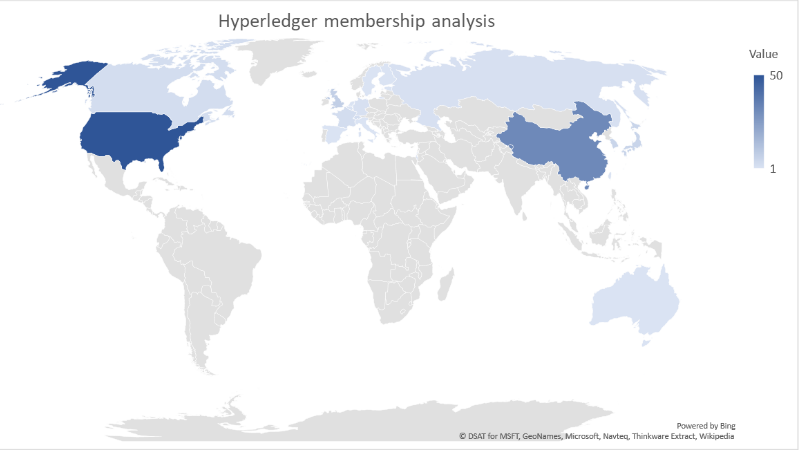
Investment in Hyperledger continues apace. New members join. In late August (2017), BTS, Oracle and Patientory joined an already large ‘club’ which has:
- 19 premier members (including Accenture, Airbus, American Express, Change Healthcare, Cisco, CME Group, Deutsche Borse Group, Daimler, Digital Asset, DTCC, Fujitsu, Hitachi, IBM, Intel, JP Morgan, NEC, R3, SAP, and Wanda FFan Technology)
- approximately 113 general members (approximately because not all are identifiable or have working web sites)
- 18 Associate Members (which includes the Bank of England and The Federal Reserve Bank of Boston amongst their number).
Geographical distribution of Hyperledger membership
Excluding the associate members, analysis indicates a reasonably broad distribution. Geographically, the 130+ combined premier and general members come from:
- 50 USA
- 32 China
- 8 UK
- 6 Japan
- 6 Korea
- 3 France
- 3 Canada
- 3 Switzerland
- 2 Germany
- 2 Other AP (Australia, Taiwan)
- 7 Other Europe (1 each for Belgium, Estonia, Finland, Italy, Netherlands, Spain, Sweden)
- 2 Russia
- 1 Israel.
Who is missing involvement? Extraordinarily, South Asia including India, most of E Asia (Japan, Korea, China and Taiwan excepted). And all of Africa and Latin America.
‘Classic’ or ‘innovative’?
Looked at from a ‘classic’ or ‘innovator’ perspective (where classic is an established business and innovator is new and almost all about blockchain in some way or form):
- 17 of the premier members are ‘classic’
- 2 of the premier members might be classed as ‘innovators’
- 49 of the general members are ‘classic’
- 53 of the general members might be classed as innovators
- 11 of the general members cannot be classified.
Of the 51 general ‘innovator’ members, 10 are Chinese and 21 are based in the USA. In other words ~60% come from just these two countries.
Industry allocation
Allocating firms to an industry is difficult. Broadly, the following apply:
- 48 software
- 22 financial services
- 13 information technology and telecommunications
- 11 services (including consulting, legal and advertising)
- 9 banking
- 7 financial exchanges
- 6 industrial (including aviation and automative)
- 3 healthcare
- 2 other services
- 1 government
Software is somewhat of a catch-all category. Many members are allocated to this simply because it was not practical to be certain a member should enter another, more specific category. With those caveats:
- the absence of government interest astonishes
- as expected, finance dominates (and this is true of ‘software’ members) once you aggregate categories
- consulting services has most of the big firms (Accenture, CapGemini, Deloitte, EY, etc)
- the involvement of industry and even healthcare is minimal.
What does this mean
In the blockchain world it is difficult to take the pulse of what is happening. There is too much, and far too much if you include cryptocurrency/ICO activty, to sort through.
To be a member of Hyperledger involves commitment, of money and people. It is one lens through which to look at the blockchain tea leaves.
This analysis confirms that finance-related activity is big and that the US and China dominate. Europe is feeble in its involvement as are industry, healthcare and government. If Hyperledger disappears into a financial strait-jacket, it should not surprise you.
One further point to make: far too many Hyperledger members do not provide headquarters details on their web sites. Caution says that those who do not should not attract business. Remarkably there are some large names in this category.
NB. Not all numbers add up to 100%, due to difficulties assigning members or to the failure of web sites or because of language incomprehension.
[Hyperledger general members include: 1WorldBlockchain, ABN Amro, Aesthetic Integration, AlphaPoint, Altoros, Anne, ANZ, BBVA, BOTUZONGHENG, RUI ZHUO XI TOU, Belink, Bitmark, Bitse, Blockchain, Blocko, Blockstream, Bloq, BNP Paribas, BNY Mellon, Broadridge, BTS, Bubi.cn, CA Technologies, Calastone, CapGemini, Chain Connected, ChainNova, China Merchants Bank, Citic, Clause, Cloudsoft, CLS, Coinplug, CollectorIQ, Colu, ConsensusBase, Consensys, Cuscal, Deloitte, EnergyBlockchain Labs, EY, Eurostep Digital, Factom, FZG360.COM, Gem (BitVault Inc), Peersafe, Guardtime, H3C, 33.CN, Hashed Health, Huawei, Hundsun, Hyperchain, Intellecteu
Irootech, Kaiser Permanente, KRX,KSD, koscom, Kubique, LedgerDomain, Libra, Loyyal,Lykke, MadHive, Milligan Partners, Miracl
Monax Industries, MonetaGo, Montran Labs, Moscow Exchange, Murphy & McGonigle, NSE, NETKI, NEX, Nokia, norbloc
NTTDATA, onchain, Oracle, Orange Magic Cube,Paxos,PDX,RadarWin,Redhat, Revelry, Samsing SDS, SANY,SBERBANK, Schroders
SECUREKEY, Gingkoo, onechain, Forms Syntron, Shenzhen Qianhai Zhaogou FS, Nexgo, Dianrong.com, SmartLink Labs, SORAMITSU, State Street, SWIFT, Swisscom, Symbiont, TAI, Tequa Creek, Patientory, Thomson Reuters, TMX, Tradeix, VMware, Wells Fargo, Yunphant, BaoQuan.com, ZhongChao Credit Card Ind. Dev. (Source: Hyperledger.org)]


























[…] Loyyal attributes many of these improvements to its proprietary implementation of the Hyperledger Fabric blockchain […]
[…] Loyyal attributes many of these improvements to its proprietary implementation of the Hyperledger Fabric blockchain […]
[…] Loyyal attributes many of these improvements to its proprietary implementation of the Hyperledger Fabric blockchain […]